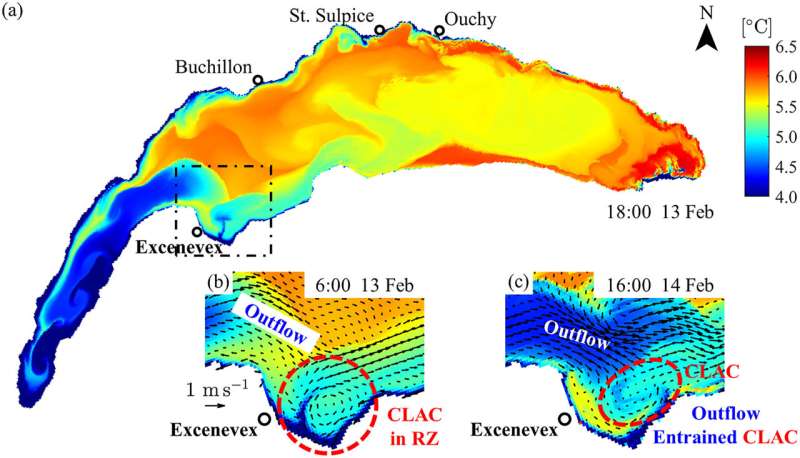This article has been reviewed according to Science X's editorial process and policies. Editors have highlighted the following attributes while ensuring the content's credibility:
fact-checked
peer-reviewed publication
trusted source
proofread
Researchers discover novel deepwater renewal process in Lake Geneva

EPFL researchers have discovered that deepwater renewal in Lake Geneva in wintertime is not only due to vertical mixing. Instead, strong currents coming from the lake's Petit Lac basin and nearshore zones of the Grand Lac play a vital role.
In temperate lakes, deep vertical mixing, known as turnover, happens during winter. As the surface water cools, it becomes denser and sinks, mixing with the deeper water. This process is important because the lake's health suffers when dissolved oxygen and nutrients are not well-distributed.
Normally, in Lake Geneva, the oxygen-rich surface water does not reach the lake bottom, which can become low in oxygen. But, in very cold winters, complete mixing occurs, making the oxygen and temperature levels the same from top to bottom. Until now, this vertical mixing was thought to be the only way to refresh the deep water in Lake Geneva.
Because of climate change, full vertical mixing is becoming less common. "Temperatures have been rising since 2012, and oxygen levels at the bottom of Lake Geneva have dropped by 90% in 10 years," says Naifu Peng, a researcher at EPFL's Ecological Engineering Laboratory (ECOL).
Peng, who specializes in simulation models, focuses on the impacts of climate change. Recently, he and ECOL colleagues examined the dynamics involved in wintertime deepwater renewal in Lake Geneva. Their findings were published recently in Water Resources Research.
Winter hydrodynamics
According to the International Commission for the Protection of the Waters of Lake Geneva (CIPEL), the last complete overturning of Lake Geneva was in the exceptionally cold winter of 2012.
For this important case, the EPFL team investigated the fundamental mechanisms underlying that complete overturning. Rather than vertical mixing alone, the research team determined that the deepwater renewal in Lake Geneva in 2012 was driven by much more complex, three-dimensional mixing processes.
Lake Geneva is composed of two basins, the large and deep Grand Lac (309 m deep, 85 km3 volume) in the east, and the smaller and shallower Petit Lac (75 m deep, 4 km3 volume) in the west—which overturns annually. Remarkably, the two-basin structure of Lake Geneva is fundamental to the renewal of the deepest layers of the Grand Lac.
The ECOL scientists used extensive field observations and numerical modeling to investigate the hydrodynamics in the entire Lake Geneva during the winter of 2012. Their combined approach uncovered the limit to vertical mixing in the Grand Lac.
"By analyzing the water temperature and oxygen concentration, we found that complete overturning due to vertical mixing did not occur in 2012 after all," explains Peng. "Using highly resolved numerical modeling, we were able to gain detailed insight into how this process played out across the lake as a whole.
"In particular, it was water flowing laterally from the Petit Lac and the shallow nearshore zones of the Grand Lac that renewed the lake's deepest layers."
Water in shallower regions of the lake cools more rapidly than in deep areas, which results in flows due to lateral contrasts in water density, culminating in renewal of water in the deepest layers of the Grand Lac. "Thus, surface cooling during winter leads to flows driven by both vertical and horizontal density gradients, which in 2012 led to complete turnover of the lake."
As climate warming continues, full-depth vertical mixing of Lake Geneva in the winter will occur only during occasional, very cold winters. However, lateral mixing processes will continue to contribute to renewal of the lake's deepest layers. "Lake Geneva is not unusual in having a two-basin structure, so the same type of winter mixing is expected in other temperate lakes."
More information: N. Peng et al, Deepwater Renewal in a Large, Deep Lake (Lake Geneva): Identifying and Quantifying Winter Cooling Processes Using Heat Budget Decomposition, Water Resources Research (2024). DOI: 10.1029/2023WR034936
Journal information: Water Resources Research
Provided by Ecole Polytechnique Federale de Lausanne


















